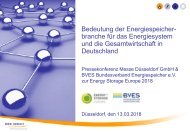Renewable Energy – Solutions for application in the communal energy infrastructure
This brochure contains a selection of successful renewable energy solutions suitable for a range of applications for local and national municipalities and economies. The main energy end-use sectors and the current state of the energy transition are briefly explained to provide readers with an understanding of the transformation of the greater energy system. The renewable energy technology options are explained, including their relevance and applications for municipalities. Finally, a selection of exemplary projects that have been successfully implemented in Europe, the Russian Federation and Central Asia, are included to demonstrate real applications and use-cases for renewable solutions. Renewable energies are cheap, clean and versatile.
This brochure contains a selection of successful renewable energy solutions suitable for a range of applications for local and national municipalities and economies. The main energy end-use sectors and the current state of the energy transition are briefly explained to provide readers with an understanding of the transformation of the greater energy system. The renewable energy technology options are explained, including their relevance and applications for municipalities. Finally, a selection of exemplary projects that have been successfully implemented in Europe, the Russian Federation and Central Asia, are included to demonstrate real applications and use-cases for renewable solutions. Renewable energies are cheap, clean and versatile.
Create successful ePaper yourself
Turn your PDF publications into a flip-book with our unique Google optimized e-Paper software.
BIOENERGY |<br />
21<br />
Functional pr<strong>in</strong>ciple and design<br />
Wood pellets are produced by compress<strong>in</strong>g wood shav<strong>in</strong>gs<br />
and sawdust without <strong>the</strong> use of any o<strong>the</strong>r additives.<br />
Pellet plants are often affiliated with sawmills.<br />
The cyl<strong>in</strong>drical pellets are typically about 6 millimetres<br />
thick and 1 to 4 centimetres long. The pellets are characterised<br />
by a higher heat<strong>in</strong>g value than wood chips and<br />
conta<strong>in</strong> little moisture.<br />
Pellet boilers are <strong>in</strong>stalled <strong>in</strong> <strong>the</strong> boiler room like o<strong>the</strong>r<br />
central heat<strong>in</strong>g systems. The fuel supply from <strong>the</strong><br />
store to <strong>the</strong> burner is managed automatically, as is <strong>the</strong><br />
control system. The combustion heat is transferred to<br />
<strong>the</strong> boiler. From here, <strong>the</strong> heat is distributed throughout<br />
<strong>the</strong> build<strong>in</strong>g via radiators, as with any o<strong>the</strong>r central<br />
heat<strong>in</strong>g system. A heat accumulator compensates <strong>for</strong><br />
any deviations between heat generation and demand.<br />
In contrast to gas and oil heat<strong>in</strong>g systems, <strong>the</strong> ash <strong>in</strong><br />
a pellet heat<strong>in</strong>g system must occasionally be removed<br />
from <strong>the</strong> collection conta<strong>in</strong>er. In <strong>the</strong> case of pellet<br />
stoves to be <strong>in</strong>stalled <strong>in</strong> <strong>the</strong> liv<strong>in</strong>g room, fuel is manually<br />
refilled <strong>in</strong>to a storage conta<strong>in</strong>er, which is <strong>the</strong>n automatically<br />
transported <strong>in</strong>to <strong>the</strong> combustion chamber.<br />
There are also special pellet stoves that can deliver up<br />
to four-fifths of <strong>the</strong>ir heat to a central heat<strong>in</strong>g system<br />
via a water bag.<br />
Wood pellet heat<strong>in</strong>g: Pellets can be stored <strong>in</strong> aboveground or<br />
underground tanks. The fuel feed to <strong>the</strong> heater works automatically.<br />
Possible <strong>application</strong>s and benefits <strong>for</strong> municipalities:<br />
Woodchips and pellets are locally produced <strong>energy</strong><br />
sources that are easy to store and, <strong>the</strong>re<strong>for</strong>e, not only<br />
reduce emissions but also <strong>in</strong>crease value creation at a<br />
local level. These are used <strong>for</strong> electricity and heat generation:<br />
• Generation of electricity and heat from wood chips <strong>in</strong><br />
cogeneration plants, e.g. <strong>for</strong> schools or community<br />
centres<br />
• Generation of district heat<strong>in</strong>g with woodchips (if<br />
possible, <strong>in</strong> cogeneration)<br />
• Operation of central heat<strong>in</strong>g systems and stoves with<br />
wood pellets<br />
Woodchips are often produced <strong>in</strong> mobile chipp<strong>in</strong>g<br />
plants directly <strong>in</strong> <strong>for</strong>ested areas or dur<strong>in</strong>g landscape<br />
ma<strong>in</strong>tenance work. Production from untreated waste<br />
wood is also possible. Wood chips are typically used<br />
<strong>for</strong> larger heat<strong>in</strong>g and cogeneration plants up to <strong>the</strong><br />
three-digit megawatt range, as <strong>the</strong>y are more cost-effective<br />
than wood pellets. Compared to wood pellets,<br />
however, <strong>the</strong>y require about three times as much storage<br />
space <strong>for</strong> <strong>the</strong> same heat<strong>in</strong>g value.<br />
In wood chip systems, <strong>the</strong> fuel and air supply are also<br />
automatically regulated accord<strong>in</strong>g to <strong>energy</strong> demand.<br />
Here, <strong>the</strong> hot flue gases from <strong>the</strong> furnace also heat <strong>the</strong><br />
water <strong>in</strong> <strong>the</strong> boiler first. In order to generate electricity,<br />
steam is produced from this, which is used to drive a<br />
turb<strong>in</strong>e. The residual heat left over after <strong>the</strong> turb<strong>in</strong>e can<br />
be used <strong>for</strong> heat<strong>in</strong>g (comb<strong>in</strong>ed heat and power). When<br />
only be<strong>in</strong>g used <strong>for</strong> heat, <strong>the</strong> boiler transfers <strong>the</strong> heat<br />
directly to <strong>the</strong> heat<strong>in</strong>g circuit or storage unit.








